Trends in Indiana's School-Age Population
Much has been made of the inevitable aging of the population both in Indiana and the nation. To be sure, our state's senior population will expand significantly in the coming decades and a modest contraction of Indiana's labor force is likely over the next twenty years. Yet, what demographic patterns can we expect to see in Indiana's younger population? Which areas of the state can expect growing school-age populations and which will experience a decline? State and county population projections recently released by the Indiana Business Research Center provide some insights into the likely growth patterns of this important age group.
Indiana's Youth: Past, Present and Future
As Figure 1 illustrates, Indiana will see its school-age population (defined here as age 5 to 19) decline by nearly 25,000 (2 percent) between 2010 and 2020. Beyond 2020, this age group will likely grow steadily over the next 20 years when it reaches a total of just under 1.4 million residents in 2040—a 3 percent increase over the current size.
Figure 1: Indiana Population Age 5 to 19, 1980 to 2040
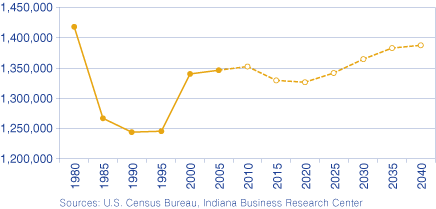
There are two primary forces behind this pattern. The first is simply the typical ebb-and-flow of demographic dynamics. For instance, a look at Figure 2 shows that in 2005 the 10-to-14 and 15-to-19 age groups are much larger than the age groups under 10. As these older cohorts get older and are replaced by the younger cohorts, Indiana will see a temporary dip in school-age children. By 2020, however, we see that the 0-to-4 and 5-to-9 age groups are considerably larger than the older cohorts and will lead the rebound in school-age population.
Figure 2: Indiana Population by Selected Age Groups, 2005 and 2020
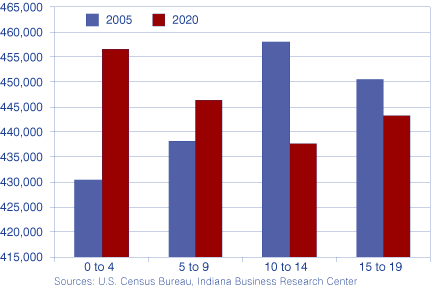
Of course, the number of children in our state is directly related to the number of adults in the prime child-bearing age groups. Therefore, the decline in the school-age population between 2010 and 2020 can be attributed to the temporary decline currently seen in the number of females between the ages of 20 and 40 (see Figure 3). As the size of this population rebounds after 2005, so does the expected school-age population 10 to 15 years later.
Figure 3: Indiana Female Population Age 20 to 40, 1995 to 2040
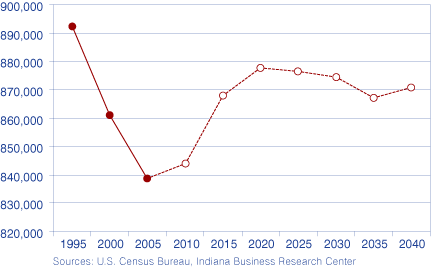
The second factor is the key assumption underlying these population projections: that the net in-migration that Indiana has experienced since the early 1990s will continue into the foreseeable future, although at a progressively lesser rate. Therefore, since migration is generally a function of economic opportunity, the realized patterns in future school-age populations will hinge on Indiana's ability to grow and evolve economically.
Returning to Figure 1, we see how the combination of demographic and migration/economic forces have produced dramatic shifts in the size of this age group in the past. The school-age population, for instance, declined by 12 percent between 1980 and 1990 as the last of the baby boom generation progressed beyond this age group in the early 1980s and the state experienced significant net out-migration throughout the decade. The school-age population rebounded in the 1990s, with a growth of nearly 8 percent as the state once again experienced net in-migration and births increased slightly with baby boomers occupying the prime child-bearing years. In-migration, while still occurring, has cooled somewhat since 2000 but births have steadily risen since the late 1990s resulting in a slight increase (0.5 percent) in the size of the school-age population between 2000 and 2005.
The impact of migration patterns on the school-age population becomes even more evident when we analyze trends at the county level.
County Patterns
The areas of Indiana that can expect a growing school-age population are those areas that will attract college graduates and young families. In Indiana, those communities figure to increasingly be in our metropolitan areas.
By 2025, when Indiana's school-age population on whole will have returned to the approximate size it held in 2005, only 13 of our state's 92 counties will have shown an increase in the population age 5 to 19 (see Figure 4). Not surprisingly, six of these 13 counties are in the Indianapolis metro area (MSA) led by Hamilton County (52 percent increase), Hendricks County (22 percent), Hancock County (20 percent), and Boone County (15 percent). Other urban or suburban counties that will show increases are Allen, Clark, Elkhart, and Porter counties. The two rural exceptions, Adams and LaGrange counties, are characterized by large Amish and Mennonite populations which tend to have higher fertility rates than the general population.
Figure 4: Percent Change in Population Age 5 to 19, 2005 to 2025
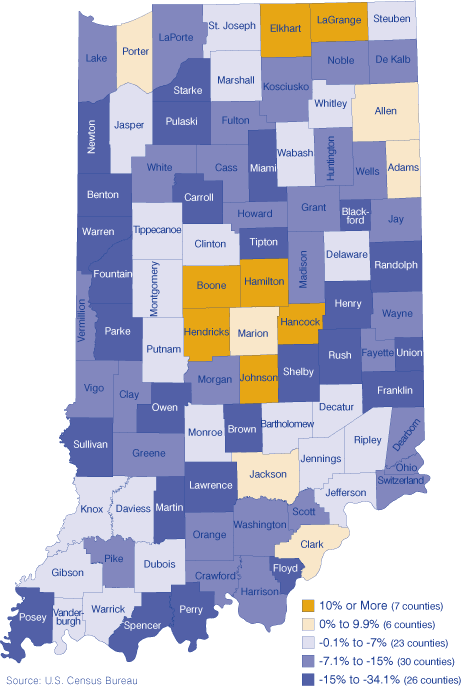
Figure 5 illustrates that by 2040, an additional 10 counties will likely exhibit a growth in its school-age population bringing the state to a total of 23 counties which will have a larger 5-to-19 population than they had in 2005. That means that over the next 30 years, three out of four Indiana counties will see a decline in these age groups.
Figure 5: Percent Change in Population Age 5 to 19, 2005 to 2040
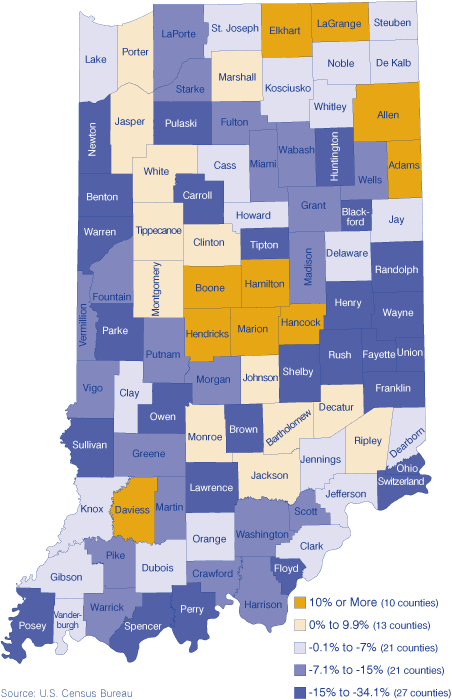
The areas to see the greatest relative losses will be nonmetro counties predominately. However, several of Indiana's metropolitan areas will see a significant decline in these age groups, as well.
A look at recent migration movements indicates why these discrepancies are likely. Figure 6 examines the net migration totals from 2000 to 2006 for Indiana and three broad subsets of the state: the Indianapolis MSA, other Indiana MSAs and nonmetro counties. In-migration to the 10-county Indianapolis metro exceeded the state total over this period by nearly 14,000 residents. Taken together, other Indiana metro areas showed very modest in-migration while nonmetro counties experienced significant out-migration.1 The effect of migration on future school-age populations in rural areas is compounded by the tendency for young adults to migrate from these areas at a greater rate than other age groups.
Figure 6: Net Migration, 2000 to 2006
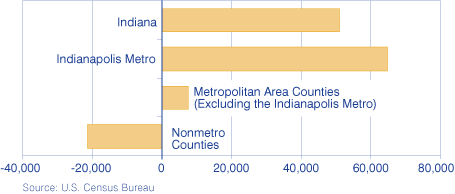
Conclusion
In many communities, these various local trends will have serious impacts on school enrollments and, by extension, school facility and human resource planning.2 Many suburban school districts can expect continued enrollment growth while some rural districts are likely to experience sharp declines. Beyond school enrollments, communities with shifting school-age populations will also have to plan for changes in social service delivery, health care availability, and recreation opportunities among other issues.
These projected trends are not set in stone, however. They are merely a reflection of what is likely to take place if the demographic and migration trends of the last 10 to 15 years continue into the future. Future economic opportunities and quality of life developments will play a large role in realized population change.
Notes
- For a more detailed analysis of migration trends over this period, see Rachel Justis, "What's Driving Population Growth in Indiana Counties and Regions?" InContext, July 2007.
- Since most counties have multiple school districts, it is not appropriate in many cases to use these county-level projections for school district analysis. Population change can vary widely within counties, particularly in fast-growing communities.
Matt Kinghorn, Demographer
Indiana Business Research Center, Kelley School of Business, Indiana University
